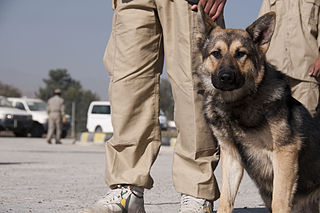Drug Dogs Don't Even Have to Be Right Half The Time to Be Considered 'Reliable' by The Courtsby Tim CushingTechdirt Feb. 11, 2016 |
Popular 
John Hagee Cheers Israel-Iran Battle as 'Gog and Magog War,' Will Lobby Congress Not to Deescalate

Right-Wing Media See Traffic Plummet in Wake of Algorithm Changes by Facebook, Google

Patriot ACT on Steroids: FISA Bill Forces 'An Enormous Range' of Businesses to Act as NSA Spies

Congress Introduces ADL-Backed 'Countering Antisemitism Act' to Police Online Speech

Reuters: Iran Gave 'Wide Notice' Days Before Attack on Israel
  All in all, this motion to suppress evidence worked out for the plaintiff, but it does little to address concerns that drug dogs are basically blank permission slips for inquisitive cops. All in all, this motion to suppress evidence worked out for the plaintiff, but it does little to address concerns that drug dogs are basically blank permission slips for inquisitive cops.The defendant -- Emile Martin -- was in a vehicle driven by another person (simply referred to as "Montgomery" in the opinion). This vehicle crossed the centerline multiple times and was pulled over by Deputy Brandon Williams. The driver could not produce registration or proof of insurance, which led to the issuance of a citationÖ eventually. But the citation process was unnecessarily prolonged to provide the deputy with a chance to have a K9 unit brought in to sniff the car for drugs. Based on its findings of fact, the court agrees that the stop was unduly prolonged in order to allow time for the canine and its handler to reach the scene. Prior to the point that the dog alerted, at 3:37 a.m., there was merely a hunch, but neither probable cause nor reasonable articulable suspicion, that criminal conduct was afoot. The lapse of 33 minutes from 3:04 a.m. to 3:37 a.m. for the stop in this case constituted a plainly unjustifiable seizure for that length of time under the Fourth Amendment. As noted above, when Deputy Williams returned to his cruiser with Montgomeryís driverís license and the Grand Prix title at or shortly after 3:11 a.m., he had everything he needed to begin writing the traffic citations.Under the Supreme Court's Rodriguez decision, officers cannot artificially prolong traffic stops in hopes of stumbling across something "better" than a traffic violation. Once the stop's "mission" has reached its conclusion, drivers are free to go, no matter how many more questions -- or dog sniffs -- the officer might wish to pursue. Still, a drug dog was brought in and it did alert during its "search" of the vehicle. This alert was also challenged, presumably in case the defendant's citation of Rodriguez failed to result in suppression. Data was obtained on the dog's ("Dul") "hit" rate. The data wasn't exactly a confirmation of Dul's superlative skills. The defendant has not presented any evidence challenging the adequacy of Dulís training and certification regimen. However, he questions Dulís reliability based on a review of the dogís performance record, both in training sessions and in the field. The defendant argues that Dulís training and field performance records suggest a failure rate of up to 25%. The evidence offered on this phase of the motion is generally undisputed.Considering law enforcement officers "ask" dogs for permission to effect warrantless searches, one would hope 75% wouldn't be an acceptable success rate. Of course, many arguments were presented by the government as to why being right only three-fourths of the time is nigh unto infallibility. According to law enforcement testimony, there are any number of reasons why a drug sniff might result in a false positive, but none of those are reasons to doubt a dog's assertions. This is the case because officers are unable to confirm false negatives in the field (as no search is conducted), may fail to find drugs where a dog correctly alerts, and may not realize a dog has alerted based on a residual odor of drugs no longer present.This would be one thing if law enforcement was alone in finding this acceptable. Unfortunately, the court also finds this lack of accuracy to be of little import when discussing the justification of a search. Dul may only be right 75% of the time, but the bar has been set so low by previous decisions that drug dogs whose intuition is worse than a coin flip are considered to be trustworthy generators of probable cause. (h/t Brad Heath) Notwithstanding the dispute regarding Dulís failure rate, the court is satisfied that in conjunction with his training and certification, his performance record amply supports the officersí reliance on his alert to support probable cause to conduct a search. Dulís performance record is superior to that of dogs which have been found to be reliable by other courts. See Green, 740 F.3d at 283-284 (affirming district courtís finding that dog with 43% success rate was reliable); United States v. Bentley, 795 F.3d 630, 636 (7th Cir. 2015) (accepting field detection rate of 59.5%); United States v. Holleman, 743 F.3d 1152, 1157 (8th Cir.) (57%).The only upside here is that the Rodriguez decision will provide a remedy for those whose stops have been artificially extended to bring in drug dogs whose "alert" means nothing more than ĮĮ\_(ツ)_/Į. In this case, the extension of the stop resulted in suppressed evidence, not the drug dog's questionable reliability. At some point, drug dogs may start being mentioned in the same breath as other law enforcement pseudoscience -- like bite mark evidence or hair comparison. But until then, dogs that can't even manage a 50% hit rate will still be allowed to give officers permission to perform warrantless searches. Dul-the-Dog (PDF) |



